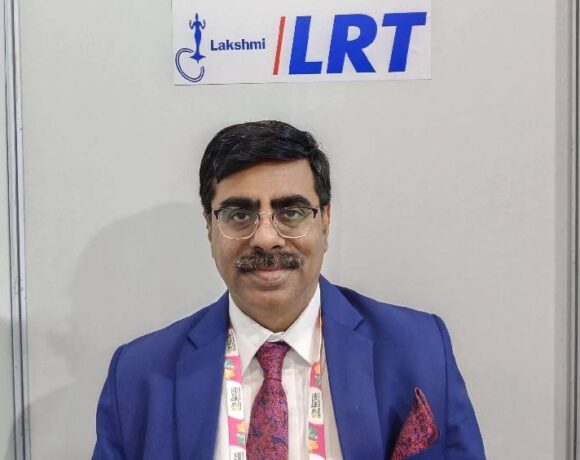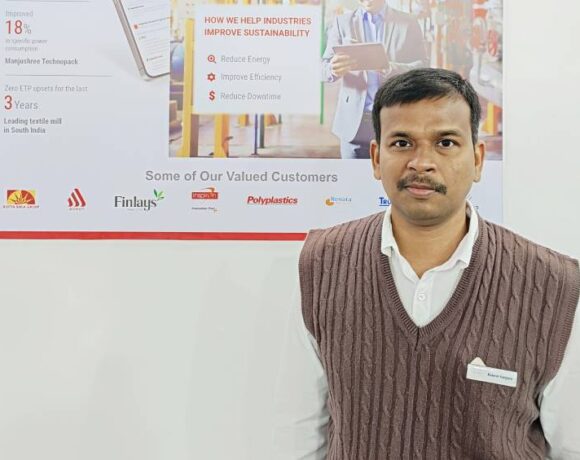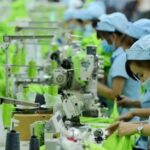‘The Outlook For India’s Knitting And Processing Industry Is Promising!’

The demand for Indian products is growing, especially in fashion-related industries. As fashion requires creativity, design innovation and programming skills, this presents a significant opportunity for young talent in India, offering them interesting and challenging roles beyond repetitive tasks, avers K M Nizar Ali, in conversation with Henry Dsouza, Associate Editor of Textile Insights.
What are the most significant emerging trends in the circular and flat knitting markets and how is Universal MEP leveraging these trends to drive growth?
The circular and flat knitting markets are witnessing significant growth, spurred by global economic shifts and evolving consumer demands. Universal MEP Projects & Engineering Services Ltd., with its extensive presence across the textile value chain, is strategically leveraging these trends to drive its growth.
One of the key factors contributing to this growth is the shift in global sourcing patterns. Economic challenges in traditional textile hubs like Sri Lanka and Bangladesh have led many global buyers to diversify their sourcing to other regions, including India, Vietnam, Turkey and Uzbekistan. India, in particular, has emerged as a preferred destination due to its stable economic and political environment. This shift has resulted in increased orders for circular and flat knits, especially benefiting companies like us, which are already well-positioned in these segments.
Another significant trend is the growing demand for synthetic fabrics. While India has traditionally been dominated by cotton-based textiles, there is now a rising interest in synthetic fabrics, particularly for sportswear and leisurewear. These segments require fine gauge and electronic knitting machines, and Universal MEP is actively participating in this market, with many big corporates already investing in or planning to enter the sportswear segment.
Additionally, new applications in circular knitting, such as knitted sheeting for bed and bath products, are gaining traction. This trend involves using circular knitting machines to produce fitted sheets with elastic, offering ease of maintenance and comfort. Universal MEP is positioning itself to cater to this emerging market, recognizing its potential for growth.
In the flat knitting sector, there is a growing demand for fashionable garments made from cotton and other materials, moving beyond the traditional association with winter garments made from wool, worsted and acrylic fibres. Universal MEP, in partnership with Shima Seiki, a world leader in flat knitting machines, is well-equipped to meet this demand. The introduction of advanced technologies like Wholegarment knitting, which allows the creation of seamless garments directly from yarn, is another area where the company sees significant growth potential.
Beyond traditional garment manufacturing, there is also a slow but steady growth in non-garment applications for knitted fabrics in India, such as filtration fabrics, medical textiles, mattress covers and shoe uppers. We are exploring these opportunities, anticipating that these niches will expand in the coming years.
Overall, we are well-positioned to capitalize on these emerging trends in the knitting industry. With strategic investments in technology and market expansion, the company is confident that these trends will drive promising growth over the next 3 to 5 years.
How would you describe the current investment climate for the knitting and processing industry in India?
The investment climate for the knitting and processing industry in India is showing signs of cautious optimism. In the circular and flat knitting sectors, there is a clear push towards new investments, driven by emerging market opportunities. While not all customers are actively investing, a significant number are returning to investment mode due to favourable market conditions.
However, when it comes to processing and finishing, the scenario is more tentative. The industry still faces gaps that need to be addressed, and many customers are adopting a “wait and watch” approach. This hesitation is largely due to the capital-intensive nature of setting up a processing facility, which requires substantial investment. Even though there is interest, many customers are not yet confident enough to proceed with large-scale investments.
Currently, most investments are concentrated in the knitting sector, as it allows for smaller, incremental investments, such as purchasing four, six, or ten machines to start with. In contrast, the processing industry requires a minimum capacity setup, including necessary infrastructure like water treatment plants, making it difficult to consider anything less than Rs 100 crore investment.
Despite the cautious approach, there are positive signs. Inquiry levels have been increasing over the past couple of months, indicating a potential uptick in investment activity. Many projects that were previously on hold are now being reconsidered, and there are plans in the pipeline, including those by larger corporate players. While the current investment climate is not as robust as it could be, there is a sense that the industry is on the brink of a recovery. With time, especially in the third and fourth quarters, we may see a stronger resurgence in both knitting and processing investments.
Which regions or states in India are emerging as key hubs for the knitting and processing industries, and what factors contribute to their growth?
Gujarat is emerging as a key hub for the knitting and processing industries in India, primarily due to favourable state policies and a well-established textile infrastructure. Historically, Gujarat has been strong in areas like ginning and spinning, but as these sectors reach a point of saturation, many companies are diversifying into circular knitting and processing. While these new ventures face initial challenges, the strong industrial background of the companies involved suggests that they will overcome these hurdles and establish Gujarat as a leading centre for these industries. This success in Gujarat is likely to inspire similar developments in other regions.
In addition to Gujarat, the southern part of India is also seeing growth, particularly in flat knitting. Traditionally concentrated in northern India, flat knitting is now gaining traction in the south due to increasing demand from buyers. Many companies are cautiously entering this sector on a smaller scale, but as they do, the need for supporting infrastructure, such as yarn dyeing facilities, is also growing. Consequently, several yarn dyeing plants are being planned to support this emerging industry.
Beyond Gujarat and the southern states, investment in knitting and processing is occurring across the country, but the pace is slower and more cautious. Most investments are focused on modernizing existing facilities and increasing capacity rather than launching new greenfield projects. This cautious optimism reflects a “wait and watch” approach prevalent in the industry, with companies gradually expanding as market conditions improve.
What are the primary challenges faced by businesses in both segments, and what opportunities do you foresee for them in the near future?
The main challenges for businesses in both segments revolve around the unpredictability of market conditions and utilization rates. After the Covid-19 pandemic, markets initially surged, but geopolitical factors, such as wars, caused a sudden drop in demand, especially in export-oriented segments like knitting. The inability to predict utilization levels creates hesitation among investors and big brands, as they are unsure whether their investments will yield the expected returns. This uncertainty is particularly pronounced in the knitting segment, where orders can be highly specific, unlike spinning and weaving, which offer more flexibility.
Another significant challenge is the decentralized and unorganized nature of the industry, with varying levels of maturity among businesses. Additionally, the lack of uniform regulations across different regions of India adds to the confusion, especially in dyeing, processing and finishing. For example, while the southern part of India mandates zero discharge, other regions allow primary treatment, leading to varying production costs within the country.
Despite these challenges, there are opportunities on the horizon. The diversification of orders is benefiting many existing customers, and the success of integrated mills compared to standalone mills is catching the attention of new entrants. This trend of diversification and integration is slowly gaining traction, with more customers considering expansion or entry into these sectors. Although the confidence level among customers is not particularly high due to the ongoing uncertainties, there is cautious optimism that the industry will continue to evolve and adapt to these challenges, opening up new avenues for growth and investment.
How competitive is India’s knitting and processing industry on a global scale, and what strategies have been employed to enhance its international competitiveness?
India’s knitting and processing industry is competitive on a global scale, particularly in terms of technology. When it comes to circular and flat knitting, the technology gap between India and other leading countries is minimal. Over the past 30 years, Indian manufacturers have increasingly recognized the importance of adopting advanced technology for survival. Today, most of the latest machinery and techniques used globally are also available in India, particularly in regions like Tirupur.
Indian manufacturers understand that high standards in technology are essential, leading to widespread adoption of advanced, high-production machines. This is a significant strength of the industry, as it ensures that India is on par with other major textile-producing nations in terms of technology.
However, one challenge is the fragmented nature of the industry in India. While other countries like China and Bangladesh have more organized, large-scale operations, India’s industry is still characterized by many small entities, with businesses often operating just a handful of machines. This fragmentation can deter some international buyers, who may hesitate to place large orders with companies that lack the capacity to handle them entirely in-house. They often prefer suppliers who offer a complete “A to Z” setup, which is less common in India.
In terms of processing, there are relatively few companies in India with capacities exceeding 20 tonnes per day. Despite interest in expanding capacities to 20, 30, or even 50 tonnes per day, many businesses remain cautious. This hesitation stems from concerns about whether they can maintain continuous operations for at least 250 days a year. Consequently, only a few processing houses have managed to scale up significantly.
Nonetheless, the quality of Indian products and workmanship is highly regarded by international buyers. While India may be slightly more expensive due to duties and other structural factors, the confidence in the quality of Indian textiles is strong. As a result, while countries like Bangladesh may attract larger volumes, India is preferred for value-added products. If the industry can overcome its challenges and become more organized, India has the potential to significantly increase its share of the global market.
What is your outlook on the future growth prospects for India’s knitting and processing industry, considering both domestic and global factors?
The outlook for India’s knitting and processing industry is promising, particularly for the knitting and knitted processing segments. We strongly believe that these sectors will continue to experience growth in the coming years. The current government’s policies, along with upcoming Free Trade Agreements (FTAs) and other supportive measures, are expected to enhance India’s attractiveness to global buyers. Over the next 3 to 5 years, we anticipate better prospects for both our customers and our industry.
Within the industry, flat knitting is likely to see stronger growth compared to other segments. This is due to the increasing demand and opportunities in this area. As a company, we are actively engaging with our customers, particularly those involved in spinning and circular knitting, to highlight the potential in flat knitting. This segment allows manufacturers to produce garments directly from dyed yarn, bypassing some intermediate processes. For businesses looking to enter garmenting or even start their own brand, flat knitting offers a low-investment entry point—around Rs 15-20 crore—to test the market and build confidence before scaling up.
On the buyer side, the demand for Indian products is growing, especially in fashion-related industries. However, the challenges are different from traditional textile production, as fashion requires creativity, design innovation, and programming skills. This presents a significant opportunity for young talent in India, offering them interesting and challenging roles beyond repetitive tasks.
India has the potential to become a leader in fashion and design, much like Italy. We are already seeing the emergence of Indian brands, particularly in cities like Bangalore, where startups are making significant strides. Supporting these ventures is crucial for developing more global brands from India.
Flat knitting, in particular, could be a catalyst for this growth. With the right support and encouragement, it could lead to a flourishing ecosystem of startups and new brands. The machinery available today is highly versatile, capable of bringing any creative idea to life. This makes flat knitting an exciting prospect, especially as India’s retail sector continues to expand.
While challenges will always exist, the overall outlook for India’s knitting and processing industry is positive. The industry is in a strong position, and with the right focus on design and innovation, it can continue to grow and succeed both domestically and globally.















